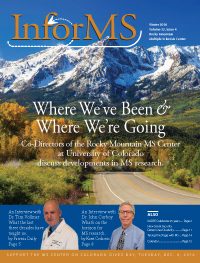MS treatments have improved significantly and people with MS can anticipate remaining involved in long careers despite their diagnosis. However, the sobering reality is that one in four of all 20 year olds will become unable to work prior to retirement. So, it is a good idea for everyone, but especially people with a chronic disease like MS, to understand whether and how they are protected if they lose the ability to work.
For most people, the critical safety net in the event of disability is Social Security Disability Insurance. It is a good idea to understand how Social Security defines disability, especially since Social Security has recently changed some of the rules for determining whether people with MS are disabled. Warning: much of this is technical. One of the main points of this article is that you will very likely need expert help as you move through the process. Also, many have asked: how does SSA determine if I am disabled? This article may serve as a good starting point.
The Social Security Administration (SSA) defines disability as the “inability to engage in any substantial gainful activity (SGA) by reason of any medically determinable physical or mental impairment which can be expected to result in death or which has lasted or can be expected to last for a continuous period of not less than 12 months.” This is a strict definition of disability. No benefits are payable for partial disability or for any disability lasting less than twelve months (unless it results in death). To apply this standard in particular cases, Social Security has developed a five-step sequential process that can be expressed in the form of questions to apply to each claimant for benefits.
Step 1: Is the individual working above SGA level?
At the first step, SSA considers an individual’s work activity, if any; and whether the work activity amounts to substantial gainful activity or SGA. SGA changes each year. For 2016, it is $1160 ($1640 for blind people). If an individual is working and his or her earnings average more than the SGA limit a month, then he or she is found not disabled. This will require many people to stop working to file an application, which can be very stressful given the uncertainties involved in the disability determination process and the relatively long-time frames usually involved. You should plan for this loss of income and possible loss of medical benefits as far in advance of an application for disability as possible.
If an individual is not working or his or her earnings are less than SGA, SSA moves to the second step.
Step 2: Is the individual’s physical and/or mental condition severe?
At the second step, SSA considers the medical severity of an individual’s impairment. To be found disabled, an individual must have a medically determinable physical or mental impairment (or a combination of impairments) that is severe and meets the duration requirement. To be severe, an impairment must at least interfere with basic work-related activities (such as standing, keyboarding, learning, focusing, etc.). To meet the duration requirement, the impairment(s) must be expected to last twelve months or to result in death. People who develop transient limitations, for example, during an MS exacerbation, will not be considered disabled unless their residual symptoms interfere with work and are expected to last for twelve months.
As a practical matter, most people with a clear diagnosis of multiple sclerosis who experience lasting MS-related limitations will generally satisfy this step and SSA will move on to the third step. However, if a claimant lacks a clear diagnosis, or has only transient workplace limitations, such as those that might arise during an exacerbation and then resolve, then the claim may be denied without further analysis.
Step 3: Does the individual’s medical condition meet or equal the severity of a listing?
At Step 3, the medical severity of a condition is further considered—this time to identify claimants so severely impaired that working would obviously be impossible under SSA rules. SSA maintains a listing of medical criteria that are considered to be so severe that further analysis of an individual’s claim is unnecessary. If an individual has an impairment that meets or equals one of the listings and meets the twelve month duration requirement, he or she is found to be disabled.
The listing for multiple sclerosis was changed in July of 2016. The new listing, which applies to new and pending claims, provide some new clarity, but other aspects of the listing remain vague. What is clearer is that patients who need bilateral support, such as a walker, are likely to meet a listing.
The specific language of the listing related to MS is as follows:
A. Disorganization of motor function in two extremities (see 11.00D1), resulting in an extreme limitation (see 11.00D2) in the ability to stand up from a seated position, balance while standing or walking, or use the upper extremities.
OR
B. Marked limitation in physical functioning and in one of the following:
- Understanding, remembering, or applying information or
- Interacting with others; or
- Concentrating, persisting, or maintaining pace
- Adapting or managing oneself.
Extreme limitation is further defined as the “inability to maintain balance in a standing position means that you are unable to maintain an upright position while standing or walking without the assistance of another person or an assistive device, such as a walker, two crutches, or two canes.”
The definition of “marked,” however, remains unclear. Accordingly, anticipating how SSA will apply the B criteria is less clear. However, listing level symptoms and limitations, by definition, are especially severe. Showing “marked” limitations in physical function and one of the four other areas may be challenging given the lack of definition.
More information about the MS listing can be found at: https://www.ssa.gov/disability/professionals/bluebook/11.00-Neurological-Adult.htm#11_09
If an individual does not have an impairment that meets or equals one of the listings, he or she may yet be found disabled at steps 4 and 5, below.
Step 4: Can the individual do any of his/her past relevant work?
At steps 4 and 5, SSA must analyze an individual’s residual functional capacity (RFC). RFC is a function-by-function assessment of an individual’s maximum ability to do sustained work-related physical and mental activities on a regular and continuing basis (8 hours a day, for 5 days per week) despite the limitations and restrictions resulting from his or her diagnosis. Both physical and mental limitations are considered. Examples of physical work-related activities include sitting, standing, walking, lifting, carrying, pushing, pulling, and manipulation. Examples of so-called mental limitations include: understanding, remembering and carrying out instructions, and dealing with changes in the workplace setting. Each of these functions (and others) will be evaluated in terms of the percentage of time that they can be done during an eight-hour day.
For people with MS who do not use assistive devices to walk (who may meet a listing at Step 3), the most important limitations may relate to the “invisible symptoms” of fatigue, heat sensitivity or cognitive problems. These symptoms, which may create limitations such as the need for rests, absences, or result in decreased pace, should be documented to the extent possible. Sometimes the best way to document these is through functional capacities evaluations (by an occupational or physical therapist) and neuropsychological testing. At the very least, the presence of these symptoms and their consequences should be carefully documented throughout the medical record.
At Step 4, SSA will compare your RFC with your ability to do your past relevant work, which generally includes all of the work you have performed during the previous fifteen years. If your RFC limits your ability to do your past relevant work as you performed it or as it generally performed in the national economy, then SSA will find that you are not disabled. If you can do your past work you are not disabled. If you cannot do your past work, SSA will move on to Step 5.
Step 5: Can the individual adjust to other that exists in significant numbers in the national economy, considering the limiting effects of the individual’s impairment, age, education, and work experience?
SSA will seek to identify other jobs that can be done given an individual’s limitations. In doing so, SSA will factor not only the MS related impairments, but also age, education, and work experience. Generally speaking, younger age, higher education, and more skilled work experience make it easier for SSA to show that you can adjust to other work. The specific medical vocational rules developed by SSA are highly technical and outside the scope of this kind of a paper. However, an example may provide some clarity.
Assume SSA finds that MS symptoms limit her to only sedentary work (able to lift and carry a maximum of 10 pounds no more than 33 percent of the time in an eight hour day, able to stand and walk at least two hours in an eight hour day). If she has only a high school education, and has done only unskilled work in the past, then a finding of disability will depend on age. If the applicant is 50 years old, she will be found disabled. If she is 44 years old, she will not.
All of the variables discussed above interact and often a vocational expert is needed to clarify whether there are jobs available in a given case. For people with MS, especially younger people who do not have significant mobility limitations, the limitations that will justify an award of disability are the same ones mentioned above at Step 4. These limitations are related to the so-called invisible MS symptoms: fatigue, heat-sensitivity, depression, cognitive problems, and pain. Limitations created by these symptoms, such as the need for rests, time off-task, decreased pace, and absences, if substantial enough, may be inconsistent with all work and justify an award of disability.
In all cases, careful medical documentation will be crucial. Make sure you have a neurologist with experience in MS. Make sure that you explain your challenges to your neurologist early, preferably even while you are still working, and especially once your symptoms begin to interfere with your work. And seek out an expert to help you throughout the process as early possible, even before you have filed your claim for disability.
Mr. Stewart directs the RMMSC’s Disability Law Program. For a free consultation, please contact RMMSC’s Disability Law Clinic at (720) 301-9708






